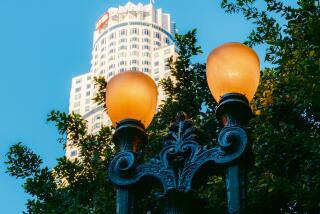Making Magic With Outdoor Light Painting
- Share via
“A little night magic” is how John Schneider describes the ways landscape lighting technology can alter the look and feel of a property and, in the process, increase its value and salability.
The owner of Landscape Lighting Systems, a Northridge-based firm, is specializing in this growing field that attempts to add personality and mood to the environment during the evening hours.
“Someone once suggested that we ‘paint’ with lights. I guess that’s pretty close to how we approach a project--it’s like working on a canvas that has been blocked out with trees, paths, steps, driveways and brooks by introducing harmonious variations in light. We do this by accenting some areas and subduing others,” Schneider said.
Because many of Schneider’s clients are celebrities who allot generous budgets to enhance their indoor-outdoor environments by deftly engineered lighting, one might assume that Schneider’s commissions are reserved for the life styles of the rich and famous.
“On the contrary, landscape lighting is much more than just glitz and glitter and can be accomplished on modest budgets,” Schneider maintains. Recently, he completed a $700 job while also carrying out a $20,000 assignment.
“One hundred years ago, Thomas Edison produced the first incandescent light bulb in America, and since that time, lighting has become a major influence on real estate in terms of exterior architecture and interior design,” Schneider said.
More often than not, outdoor lighting is used to provide better identification and increased security, he added. “But with the sophisticated techniques available to us today, a well-designed system can achieve a total transformation of the environment.”
One way to enhance the relationship between a house and its grounds is to light the perimeters to create a feeling of enclosure, Schneider said, and since outdoor illumination looks more natural if the light source is hidden, it is often effective to reflect the light from trees, shrubs or walls.
“Sometimes we illuminate a landscape by combining up-lighting and down-lighting, or using subtle lighting accents on sculptures, fountains, pools or ponds. We experiment a lot in determining which of the natural or man-made elements will be required,” he said.
A family’s lighting needs will determine what types of lighting work best--high or low voltage, incandescent, fluorescent or high-intensity discharge lights (mercury vapor).
“We take into consideration that some people entertain large groups in their backyard and others prefer intimate dinner parties. Life style is definitely the most important influence on lighting design,” he said.
Schneider begins with an on-site field study design, and all the work is carried out under his supervision, without subcontractors. Landscape Lighting Systems employs electricians, installers and maintenance workers.
In describing colors to a client, he explains the reaction between the lights and the green material (plants).
That relationship is dependent on the density of the leaf material and the amount of chlorophyll in it; thinner materials with less chlorophyll turn yellow green, while those that are thicker and have more chlorophyll turn darker.
“We tailor each installation to the needs of a property, often solving unusual problems,” Schneider said.
At Gary and Nancy Plotkin’s home in Bel-Air, Schneider solved a problem of flower-eating deer by placing an infrared trip system to act as a humane deterrent. When deer cross the sensor beam, a startlingly bright light is turned on for four minutes to keep the animals away.
Schneider said a 600-watt installation costs 4 cents an hour to operate, while 1,000 watts cost 6 1/2 cents an hour.
Lighting systems operate either from a single light switch or time clock to digitally programmed controllers in the more elaborate installations.
More to Read
The biggest entertainment stories
Get our big stories about Hollywood, film, television, music, arts, culture and more right in your inbox as soon as they publish.
You may occasionally receive promotional content from the Los Angeles Times.










